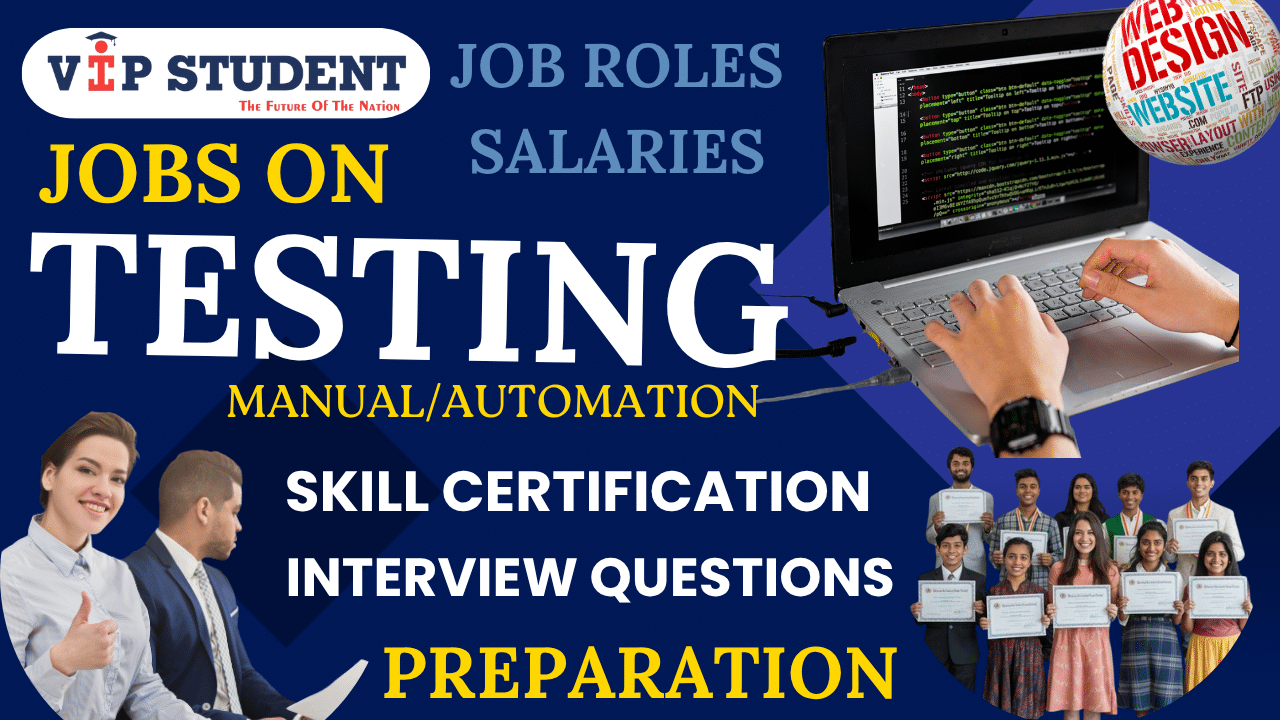LET’S KNOW ABOUT JOBS ON SOFTWARE TESTING SKILLS (MANUAL, AUTOMATION), JOB ROLES, SALARIES, INTERVIEW QUESTIONS, CAREER OPPORTUNITES AND GET CERTIFIED ON YOUR SOFTWARE TESTING SKILLS.
JOBS ON SOFTWARE TESTING SKILLS (MANUAL, AUTOMATION): In today’s technology-driven world, software testing has become a critical part of the software development lifecycle (SDLC). As companies aim to deliver high-quality software products, the demand for skilled software testers continues to grow. Whether you’re a fresher looking for your first IT job or an experienced professional seeking a career shift, software testing offers a wide range of opportunities.
Software testing is the process of evaluating a software application or system to identify bugs, errors, or gaps in requirements. The goal is to ensure that the software meets the expected quality standards and performs as intended. Testing helps in detecting issues early, which saves time, money, and improves customer satisfaction.
Career in Software Testing:
A career in software testing is both rewarding and stable. Here are some key reasons to consider this field:
- High Demand: Every software product needs to be tested before release.
- Opportunities Across Industries: From banking to e-commerce, testers are in demand everywhere.
- Growth Potential: There are numerous career advancement paths.
- Good Salary Packages: Testers with experience and certifications are well-paid.
- Work-Life Balance: Many testing roles offer flexible schedules.
Popular Testing Job Roles and Career Opportunites – Jobs on Software Testing
Software testing includes multiple job roles, each with its own responsibilities and skill sets. Let’s take a closer look at some of the most popular roles in this domain:
1. Manual Tester
Role: Manual testers execute test cases without using any automation tools. They simulate real-world user scenarios to identify bugs.
Skills Required:
- Understanding of SDLC and STLC
- Writing and executing test cases
- Good analytical and communication skills
Who Should Consider: Freshers or those who are starting their career in IT.
2. Automation Tester
Role: Automation testers use tools like Selenium, QTP, or TestComplete to automate repetitive testing tasks.
Skills Required:
- Programming knowledge (Java, Python, etc.)
- Familiarity with automation tools
- Test script development
Career Benefit: Automation testers are in high demand and often command higher salaries.
3. Quality Assurance (QA) Engineer
Role: QA Engineers focus on the entire testing process, from planning to execution. They work closely with development teams to ensure quality delivery.
Skills Required:
- Knowledge of QA methodologies
- Writing test plans and strategies
- Strong documentation skills
Tools Used: JIRA, Bugzilla, TestRail
4. Performance Tester
Role: Performance testers assess the speed, scalability, and stability of an application under different conditions.
Skills Required:
- Experience with tools like LoadRunner, JMeter
- Understanding of performance metrics
- Problem-solving and analytical skills
Use Case: Important in banking, gaming, and high-traffic platforms.
5. Security Tester
Role: Also known as penetration testers, they identify vulnerabilities in software to protect against cyber-attacks.
Skills Required:
- Knowledge of security protocols
- Ethical hacking certifications (CEH, OSCP)
- Risk assessment skills
Scope: Critical in fintech, healthcare, and defense industries.
6. Test Lead / Test Manager
Role: These are senior-level positions responsible for managing a team of testers, planning resources, and ensuring timely delivery of test projects.
Skills Required:
- Leadership and project management
- Test planning and reporting
- Team collaboration
Eligibility: Requires 5+ years of experience in testing.
Emerging Testing Roles – Jobs on Software Testing
With technological advancements, new roles are emerging in the testing domain:
DevOps Testing
In DevOps, testing is integrated with continuous integration and delivery (CI/CD) pipelines. Testers need to work in sync with developers and operations teams.
AI/ML Testing
AI-based applications require specific testing techniques, including model validation and output accuracy checks.
Cloud Testing
As companies migrate to cloud platforms, testers need to verify functionality, performance, and security in a cloud environment.
Industries Hiring Software Testers
Almost every industry that uses software solutions hires software testers. Common industries include:
- IT Services and Consulting
- Banking and Financial Services
- E-commerce and Retail
- Healthcare and Pharma
- Telecom and Networking
- Media and Entertainment
Top Companies Hiring for Testing Roles- Jobs on Software Testing
Here are some of the top companies actively hiring software testers:
- TCS
- Infosys
- Wipro
- Capgemini
- Cognizant
- Accenture
- HCL Technologies
- IBM
- Amazon
Educational Qualifications and Certifications- Jobs on Software Testing
Educational Background
- Bachelor’s degree in Computer Science, IT, or related field
- Engineering graduates (B.E./B.Tech) preferred
- Non-IT graduates can also pursue testing through certification programs
Popular Certifications
- ISTQB (International Software Testing Qualifications Board)
- Certified Software Tester (CSTE)
- Selenium Certification
- Certified Ethical Hacker (CEH) – for security testers
These certifications improve your resume and open better job opportunities.
Essential Skills for a Testing Career:
To succeed as a tester, one must have:
- Attention to detail
- Strong communication skills
- Analytical and logical thinking
- Basic programming knowledge
- Understanding of databases and SQL
- Experience with testing tools
Soft skills like patience, adaptability, and curiosity also play a key role in becoming a successful tester.
Start a Career in Testing:
Here’s a step-by-step approach for beginners:
- Learn the Basics – Understand SDLC, STLC, types of testing.
- Get Trained – Join online or offline courses.
- Build a Portfolio – Work on dummy projects or contribute to open-source testing.
- Get Certified – Consider ISTQB or Selenium certifications.
- Apply for Jobs – Use platforms like LinkedIn, Naukri, Indeed, and company career portals.
Future Scope of Software Testing
With the rise of Agile, DevOps, and AI-based applications, testing is evolving. Testers now need to learn coding, scripting, and tools to keep up with modern practices.
Automation, continuous testing, and cloud testing will dominate the future, making testing a dynamic and promising career path.
Software Testing Job Roles and Average Salaries (India)
| Job Role | Experience Level | Average Annual Salary (INR) |
|---|---|---|
| Manual Tester | 0–2 years (Fresher) | ₹2.5 – ₹4.5 Lakhs |
| 2–5 years (Mid-level) | ₹5 – ₹7 Lakhs | |
| Automation Tester | 1–3 years | ₹4 – ₹6 Lakhs |
| 3–6 years | ₹6.5 – ₹10 Lakhs | |
| QA Engineer | 2–4 years | ₹5 – ₹8 Lakhs |
| 5+ years | ₹8 – ₹12 Lakhs | |
| Performance Tester | 2–4 years | ₹6 – ₹9 Lakhs |
| 5+ years | ₹10 – ₹14 Lakhs | |
| Security Tester | 2–5 years | ₹7 – ₹12 Lakhs |
| 5+ years + Certifications | ₹12 – ₹18 Lakhs | |
| Test Lead / Manager | 6–10 years | ₹12 – ₹20 Lakhs |
| DevOps Tester | 3–6 years | ₹7 – ₹12 Lakhs |
| AI/ML Tester | 3–6 years | ₹8 – ₹15 Lakhs |
| Cloud Tester | 3–6 years | ₹8 – ₹14 Lakhs |
Jobs on Software Testing – Manual Testing Interview Questions and Answers
1. What is Software Testing?
Software testing is the process of evaluating a software application to detect defects and ensure that it meets the desired requirements.
2. What is Manual Testing?
Manual testing is the process of manually executing test cases without using automation tools.
3. What is the difference between QA and Testing?
QA ensures quality in the process, while testing focuses on identifying bugs in the product.
4. What is the SDLC?
SDLC (Software Development Life Cycle) is a process for planning, creating, testing, and deploying an information system.
5. What is STLC?
STLC (Software Testing Life Cycle) defines the stages involved in testing activities from requirement analysis to test closure.
6. What are the different types of testing?
Unit Testing, Integration Testing, System Testing, Acceptance Testing, Smoke Testing, Regression Testing, etc.
7. What is a Test Case?
A test case is a set of steps executed to verify a specific function or feature of an application.
8. What is a Test Plan?
A test plan is a detailed document outlining the scope, approach, resources, and schedule for testing.
9. What is a Bug?
A bug is an error or flaw in a software program that produces incorrect or unexpected results.
10. What is the difference between a Bug, Defect, and Error?
-
Error: Mistake by the developer
-
Defect: Issue found during testing
-
Bug: Defect accepted by the development team
11. What is the difference between Severity and Priority?
-
Severity: Impact of the defect on the application
-
Priority: Order in which defect should be fixed
12. What is a Test Scenario?
A test scenario is a high-level description of what to test in an application.
13. What is a Test Script?
A test script is a detailed set of instructions to perform a test.
14. What is Regression Testing?
Testing existing functionalities after code changes to ensure nothing is broken.
15. What is Retesting?
Re-executing test cases that previously failed, after bugs have been fixed.
16. What is Smoke Testing?
Initial testing to check whether the major functionalities work.
17. What is Sanity Testing?
Focused testing to verify specific functionalities after minor changes.
18. What is Black Box Testing?
Testing without any knowledge of the internal code or structure.
19. What is White Box Testing?
Testing with knowledge of internal code and logic.
20. What is a Traceability Matrix?
A document mapping requirements to test cases to ensure full coverage.
21. What is Exploratory Testing?
Testing done without predefined test cases, relying on tester’s experience.
22. What is Ad-hoc Testing?
Informal testing without any planning or documentation.
23. What is Boundary Value Analysis (BVA)?
Testing at the edge boundaries of input ranges to find defects.
24. What is Equivalence Partitioning?
Dividing input data into valid and invalid partitions for testing one representative value from each.
25. What is User Acceptance Testing (UAT)?
Final testing done by the end users to ensure the system meets their requirements.
26. What is the difference between Verification and Validation?
-
Verification: Are we building the product right? (process-oriented)
-
Validation: Are we building the right product? (product-oriented)
27. What is the Defect Life Cycle?
The stages a defect goes through from identification to closure: New, Open, Fixed, Retest, Closed.
28. What is Compatibility Testing?
Testing software on different browsers, devices, and operating systems.
29. What is Usability Testing?
Testing to evaluate how user-friendly and intuitive the application is.
30. What is Test Data?
Data used to execute test cases during testing.
31. What would you do if a developer disagrees with your reported bug?
Provide detailed steps to reproduce, screenshots, and logs; communicate respectfully and collaborate to clarify the issue.
32. How do you prioritize test cases when time is limited?
Focus on critical features, high-risk areas, and business-critical functionality first.
33. How do you report a bug?
Using a bug tracking tool (like JIRA), include title, description, steps to reproduce, expected vs actual results, severity, and screenshots.
34. What is Test Coverage?
A measure of how much of the application’s code or requirements have been tested.
35. How do you write effective test cases?
Include clear steps, expected results, test data, preconditions, and a unique ID.
36. Why is Requirement Analysis important in testing?
It helps understand what needs to be tested and identify potential risks early.
37. Can you test without requirements?
Yes, through exploratory and ad-hoc testing by understanding application behavior.
38. What is End-to-End Testing?
Testing the complete flow of an application from start to finish to ensure system integrity.
39. What are Test Metrics?
Quantitative measures like test case execution rate, defect density, and pass/fail rates to track testing progress.
40. What tools are commonly used in Manual Testing?
Tools like JIRA, Bugzilla, TestLink, Mantis, and Excel for test case management and bug tracking.
41. What is the difference between Test Case and Use Case?
-
Test Case: Specific steps to test a feature.
-
Use Case: Describes how a user interacts with the system.
42. What is Static Testing?
Reviewing documents, code, or design without executing the program.
43. What is Dynamic Testing?
Testing done by executing the code to find defects.
44. What are Non-Functional Testing types?
Includes Performance, Load, Stress, Security, and Usability Testing.
45. What is Defect Leakage?
Defects missed during testing that are found later in production.
46. What is a Blocker Bug?
A defect that prevents further testing or blocks system operation.
47. What is the difference between Test Strategy and Test Plan?
-
Test Strategy: High-level approach and objectives for testing.
-
Test Plan: Detailed document specifying how testing will be done.
48. What is Alpha Testing?
Internal testing performed by developers or testers before releasing to users.
49. What is Beta Testing?
Testing done by actual users outside the organization before final release.
50. Why is documentation important in Manual Testing?
Ensures traceability, helps reproduce issues, and provides evidence of testing.
Jobs on Software Testing – Automation Testing Interview Questions and Answers
1. What is Automation Testing?
Automation testing uses specialized tools to execute test cases automatically, increasing efficiency and coverage compared to manual testing.
2. What are the benefits of Automation Testing?
It saves time, improves accuracy, allows for frequent regression testing, and increases test coverage.
3. Name some popular Automation Testing tools.
Selenium, QTP/UFT, TestComplete, Appium, JMeter, and Robot Framework.
4. What is Selenium?
Selenium is an open-source tool used for automating web browsers.
5. What are the different components of Selenium?
Selenium WebDriver, Selenium IDE, Selenium Grid, and Selenium RC (now deprecated).
6. What is Selenium WebDriver?
A programming interface to create and execute test scripts in various programming languages.
7. What languages are supported by Selenium WebDriver?
Java, C#, Python, Ruby, JavaScript, and Kotlin.
8. What is the difference between Selenium IDE and Selenium WebDriver?
Selenium IDE is a record-and-playback tool, whereas WebDriver is used for creating complex test scripts with programming languages.
9. What is Test Automation Framework?
A set of guidelines, standards, and tools used to create and design test cases.
10. Name different types of Automation Testing Frameworks.
Linear Scripting, Modular, Data-Driven, Keyword-Driven, Hybrid, and Behavior Driven Development (BDD).
11. What is Data-Driven Testing?
Testing method where test data is read from external sources like Excel or CSV to run the same test with multiple data sets.
12. What is Keyword-Driven Testing?
A framework where test cases are written using keywords representing actions.
13. What is the difference between Data-Driven and Keyword-Driven frameworks?
Data-Driven focuses on data variations, while Keyword-Driven focuses on action keywords to represent user interactions.
14. What is Continuous Integration (CI) in Automation?
A practice where developers integrate code into a shared repository frequently, and automated tests run to detect defects early.
15. What tools are commonly used for Continuous Integration?
Jenkins, Bamboo, TeamCity, and Travis CI.
16. How do you handle dynamic elements in Selenium?
By using dynamic locators like XPath with contains(), starts-with(), or CSS selectors.
17. What are the types of waits available in Selenium?
Implicit Wait, Explicit Wait, and Fluent Wait.
18. What is the difference between Implicit Wait and Explicit Wait?
Implicit Wait is a global wait applied to all elements, while Explicit Wait is applied to a specific element with a condition.
19. What is Page Object Model (POM)?
A design pattern that creates an object repository for web elements, enhancing code readability and maintenance.
20. What is the advantage of using POM?
Improves test script maintenance and reduces code duplication.
21. What is a Locator in Selenium?
A mechanism to find elements on a web page, like id, name, class, XPath, or CSS selector.
22. How do you handle alerts in Selenium?
Using Alert interface methods: accept(), dismiss(), getText(), and sendKeys().
23. What is the difference between assert and verify commands in automation?
Assert stops the test execution on failure; Verify logs the failure but continues execution.
24. What is the role of TestNG in Automation?
TestNG is a testing framework inspired by JUnit, used to manage test cases, groups, parallel execution, and reporting.
25. What is the difference between TestNG and JUnit?
TestNG supports annotations, parallel test execution, and data-driven testing better than JUnit.
26. How do you handle multiple windows in Selenium?
By switching between window handles using driver.getWindowHandles() and driver.switchTo().
27. What is a Headless Browser?
A browser simulation without a GUI, used for faster test execution.
28. Name some headless browsers.
Headless Chrome, PhantomJS, and HtmlUnitDriver.
29. How do you take screenshots in Selenium?
Using TakesScreenshot interface and the getScreenshotAs() method.
30. What is the difference between Automation Testing and Manual Testing?
Automation uses tools for execution; manual is human-driven. Automation is faster but requires scripting skills.
31. What are the limitations of Automation Testing?
High initial cost, requires skilled testers, not suitable for UI changes or exploratory testing.
32. What is Cross-Browser Testing?
Testing the application across different browsers to ensure consistent behavior.
33. How can you handle exceptions in Selenium scripts?
Using try-catch blocks and Selenium-specific exceptions like NoSuchElementException.
34. What is the use of the ‘driver.quit()’ method?
Closes all browser windows and ends the WebDriver session.
35. What is the difference between ‘driver.close()’ and ‘driver.quit()’?
driver.close() closes the current browser window, while driver.quit() closes all windows.
36. What is BDD (Behavior Driven Development)?
A development approach where tests are written in natural language using frameworks like Cucumber.
37. What is Cucumber?
A BDD framework that allows writing tests in Gherkin language, which is readable by non-technical people.
38. What are feature files in Cucumber?
Files containing scenarios written in Gherkin syntax to describe application behavior.
39. What is the role of hooks in Cucumber?
Hooks allow setup and teardown actions before or after scenarios or test cases.
40. How do you perform database testing in Automation?
By connecting to the database using JDBC and executing SQL queries to verify data.
41. What is Jenkins used for in Automation Testing?
It automates the execution of test scripts and integrates with CI/CD pipelines.
42. What are some common exceptions in Selenium?
NoSuchElementException, TimeoutException, StaleElementReferenceException.
43. How do you handle frames in Selenium?
Using driver.switchTo().frame() with frame index, name, or WebElement.
44. What is the role of assertions in test automation?
To validate that the application behaves as expected.
45. What is Test Data Management in Automation?
Creating and managing data required to execute automated tests.
46. What is the difference between ‘findElement()’ and ‘findElements()’?
findElement() returns the first matching element; findElements() returns a list of all matching elements.
47. How do you handle file uploads in Selenium?
By sending the file path to the input element of type ‘file’ or using third-party tools.
48. What is the Page Factory in Selenium?
An optimized way to initialize web elements using annotations like @FindBy.
49. How do you manage test reports in Automation?
Using tools like TestNG reports, ExtentReports, or Allure Reports.
50. What skills are important for an Automation Tester?
Programming knowledge, understanding of testing concepts, familiarity with tools, analytical skills, and problem-solving.
GENERAL JOB INTERVIEW QUESTIONS AND SAMPLE ANSWERS
1. Tell me about yourself.
General Answer:
you have to tell about your self minimum 3 to 5 minits – Tell about your personal details like your name , parents and siblings and what they do , your location and its famous for, your acadamics like your school name, college name and mention marks you are obtained in 10th class, intermediate, graduation, post graduation (as per your education) and your school or college known for, your certification cources, your projects, your achivements , your tallents, your hobbies and skills you are good at like communication, problem-solving, and teamwork.
And conclude with “I’m looking forward to contributing my skills and strengths to a great/new organization while continuing to learn new skills and to develope my strengths.”
2. What are your strengths?
General Answer:
“My strengths include being organized, reliable, and a quick learner. I’m also good at working with others and staying calm under pressure.”
3. What is your greatest weakness?
General Answer:
“Sometimes I focus too much on details because I want everything to be perfect. However, I’ve been working on managing my time better and knowing when to move on to the next task.”
4. Why do you want to work here?
General Answer:
“I’ve heard positive things about the company’s culture and growth opportunities. I’m excited about the chance to work in an environment that values learning and teamwork.”
5. Why should we hire you?
General Answer:
“I believe I can bring value through my work ethic, adaptability, and eagerness to learn. I’m confident I can quickly become a productive member of your team.”
6. Where do you see yourself in 5 years?
General Answer:
“In five years, I hope to be in a position where I’ve gained more experience, taken on new challenges, and grown professionally within the company.”
7. Describe a challenge you’ve faced and how you handled it.
General Answer:
“I faced a situation where deadlines were tight and priorities were shifting. I stayed focused, managed my time well, and communicated clearly with my team, which helped us complete the project successfully.”
8. How do you handle stress and pressure?
General Answer:
“I try to stay calm and focused by organizing my tasks and taking short breaks when needed. I also talk to teammates or supervisors if I need support.”
9. Do you prefer to work independently or in a team?
General Answer:
“I’m comfortable with both. I enjoy collaborating and learning from others, but I can also stay focused and productive when working on my own.”
10. Do you have any questions for us?
General Answer:
“Yes, I’d like to know more about the daily responsibilities of the role and what the team culture is like.”
Software Testing Conclusion:
Software testing is no longer a support function—it’s a strategic part of product development. The field offers a variety of job roles, competitive salaries, and immense growth opportunities. Whether you’re a fresher or an experienced professional, a career in testing can be your gateway to the IT world.






